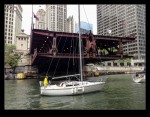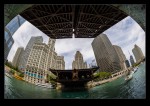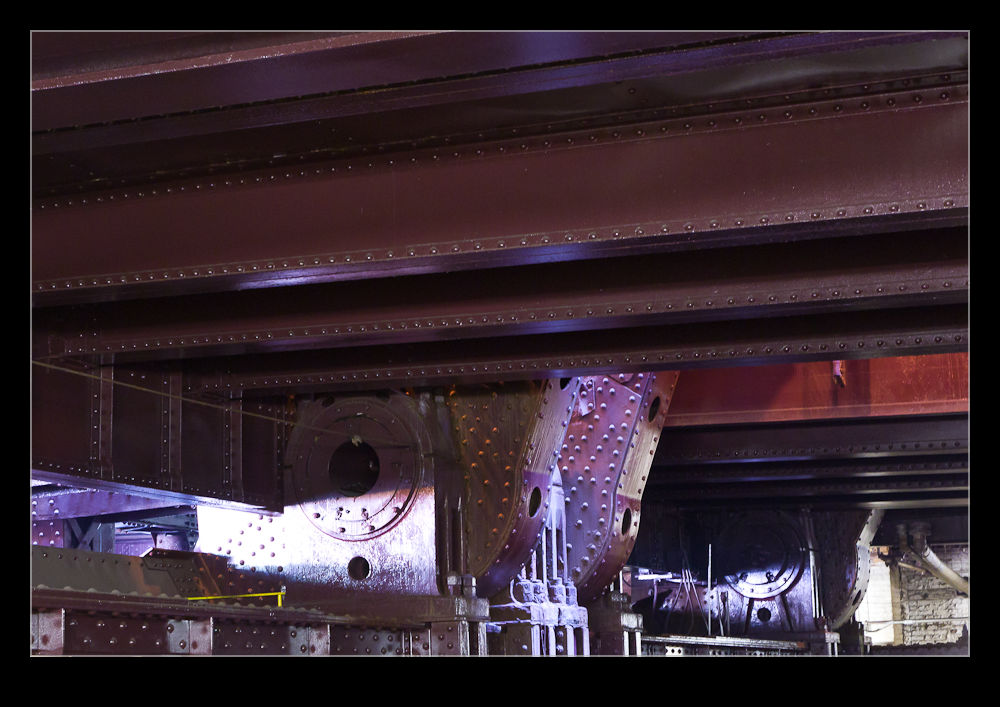 The railway that runs from Seattle up to Everett and either on to Vancouver or east across the Cascades crosses a bridge that is just outside the locks at Ballard. The bridge is a bascule bridge and, since there is quite regular boat traffic including sailing boats with high masts, it is frequently opened. The low winter light does a nice job of illuminating the underside of the deck of the bridge when it is open. I was more interested in the shapes at the end of the bridge where the rails end. They are clearly shaped to interlock with the opposite rails on the bridge approach and also to have a shape which allows the wheels to smoothly pass over without some sudden impact forces. As they stand up in the air, they strike me as rather fascinating.
The railway that runs from Seattle up to Everett and either on to Vancouver or east across the Cascades crosses a bridge that is just outside the locks at Ballard. The bridge is a bascule bridge and, since there is quite regular boat traffic including sailing boats with high masts, it is frequently opened. The low winter light does a nice job of illuminating the underside of the deck of the bridge when it is open. I was more interested in the shapes at the end of the bridge where the rails end. They are clearly shaped to interlock with the opposite rails on the bridge approach and also to have a shape which allows the wheels to smoothly pass over without some sudden impact forces. As they stand up in the air, they strike me as rather fascinating.
Tag Archives: bascule
Montlake Bridge Opening
 Our days living in Chicago included a lot of bridge raising experiences. The bascule bridges along the Chicago River were a constant source of interest to me and, despite seeing them raise regularly during the spring and fall boat runs, I never got bored of it. There are a bunch of bascule bridges in the Seattle area too. One of the older ones is the bridge across the Montlake Cut near the University of Washington.
Our days living in Chicago included a lot of bridge raising experiences. The bascule bridges along the Chicago River were a constant source of interest to me and, despite seeing them raise regularly during the spring and fall boat runs, I never got bored of it. There are a bunch of bascule bridges in the Seattle area too. One of the older ones is the bridge across the Montlake Cut near the University of Washington.
 I took a bike ride that cross Lake Washington on the 520 bridge and that then turned up to the university and across the Cut. Just as I started across the bridge, the warning tones started. I was already heading across so didn’t stop but, once on the other side, I did pause to watch the bridge open. It took me right back to my Chicago days. I didn’t wait for it to lower again because I wanted to keep going on my ride but a fun thing to see again. I imagine the traffic backups make the bridge openings a little less popular with motorists and I suspect I would have been a bit miffed if I had been a few seconds later! I hope they turn the power off for the wires!
I took a bike ride that cross Lake Washington on the 520 bridge and that then turned up to the university and across the Cut. Just as I started across the bridge, the warning tones started. I was already heading across so didn’t stop but, once on the other side, I did pause to watch the bridge open. It took me right back to my Chicago days. I didn’t wait for it to lower again because I wanted to keep going on my ride but a fun thing to see again. I imagine the traffic backups make the bridge openings a little less popular with motorists and I suspect I would have been a bit miffed if I had been a few seconds later! I hope they turn the power off for the wires!
Blue Bridge

A new Johnson Street bridge has recently opened across part of Victoria Harbour. It has replaced an old bridge that was apparently in bad condition. The new structure is a bascule bridge to allow larger boat traffic to access the inner areas of the harbor and it has a really cool design. While the bridge carries the road across the water, it has excellent access on either side for other users. The two sides carry both bike and foot traffic and they are wide enough to provide plenty of space for all users. There was plenty of foot traffic when I was there which might have had something to do with the Christmas Parade that evening.

In the evening, the bridge is well illuminated. The curvy nature of the structure provides lots of interesting details. The mechanism for raising the bridge is not concealed either so you can see the gear wheels involved in lifting it if you look below. On my walk back one evening I ended up spending a fair bit of time on the bridge because it provided so many possible angles to shoot it either to get the full bridge or to focus in on individual parts of it.
Fremont Bridge
 Bascule bridges were a popular thing for me when we lived in Chicago. The Chicago River was crossed by many of them and I liked watching them being opened when the sailboats were entering or leaving the lake. Fremont also has a bascule bridge and it is really nicely looked after. It is well painted and seems to have a few decorative elements. We also got lucky with it opening as we were walking along the trail that runs underneath it. I wonder how good it looks at night. I guess I will have to come back and find out!
Bascule bridges were a popular thing for me when we lived in Chicago. The Chicago River was crossed by many of them and I liked watching them being opened when the sailboats were entering or leaving the lake. Fremont also has a bascule bridge and it is really nicely looked after. It is well painted and seems to have a few decorative elements. We also got lucky with it opening as we were walking along the trail that runs underneath it. I wonder how good it looks at night. I guess I will have to come back and find out!
Bridge Lifts and Boat Passage
 The movement of boats to Lake Michigan is a spring event with the bridges along the Chicago River being opened to allow the boats to get by without having to remove their masts. It happens every spring and they all return each fall. After many years in Chicago, you would think I had got bored with this but I still find it a really cool thing to watch. They move on Wednesdays and Saturdays. I often don’t realize it is happening until I look out of the window and see the bridges up. I decided this year I wanted to see a little more of it.
The movement of boats to Lake Michigan is a spring event with the bridges along the Chicago River being opened to allow the boats to get by without having to remove their masts. It happens every spring and they all return each fall. After many years in Chicago, you would think I had got bored with this but I still find it a really cool thing to watch. They move on Wednesdays and Saturdays. I often don’t realize it is happening until I look out of the window and see the bridges up. I decided this year I wanted to see a little more of it.
 I got out to the river when the boats were at the join between the north and south branches. This section of the river has a bunch of bridges but they seem to have a pattern of opening them in quick succession with multiple bridges open at once. As they get up to Michigan Avenue, they do each bridge one at a time to minimize the traffic disruption since the cars get backed up while the bridges are open. A Saturday often results in a few more boats and this was no exception.
I got out to the river when the boats were at the join between the north and south branches. This section of the river has a bunch of bridges but they seem to have a pattern of opening them in quick succession with multiple bridges open at once. As they get up to Michigan Avenue, they do each bridge one at a time to minimize the traffic disruption since the cars get backed up while the bridges are open. A Saturday often results in a few more boats and this was no exception.
 I am actually cheating a bit here since, when I first started putting together this post, I had been out to watch a run of the boats. Before it is finished, though, another week had passed and another run of the boats took place. The weather was also slightly better. I decided to go out with the fish-eye this time to get something a little different to add to the collection so now the shots are a little more diverse and, hopefully, a little more interesting.
I am actually cheating a bit here since, when I first started putting together this post, I had been out to watch a run of the boats. Before it is finished, though, another week had passed and another run of the boats took place. The weather was also slightly better. I decided to go out with the fish-eye this time to get something a little different to add to the collection so now the shots are a little more diverse and, hopefully, a little more interesting.
Michigan Avenue Bridgehouse
 The Chicago tourist activities have been continuing. Another local attraction I have never been to – and this one has no excuse since I have known about it for ages and it is visible from my window! – is the bridgehouse for the Michigan Avenue bridge.
The Chicago tourist activities have been continuing. Another local attraction I have never been to – and this one has no excuse since I have known about it for ages and it is visible from my window! – is the bridgehouse for the Michigan Avenue bridge.
 Chicago has a large number of movable bridges across the Chicago and Calumet rivers. A large number of them are bascule bridges. For those of you not familiar with French descriptions of bridges, bascule bridges are counterbalanced and rotate out of the way using very little power due to the excellent balance. (Bascule is French for seesaw.)
Chicago has a large number of movable bridges across the Chicago and Calumet rivers. A large number of them are bascule bridges. For those of you not familiar with French descriptions of bridges, bascule bridges are counterbalanced and rotate out of the way using very little power due to the excellent balance. (Bascule is French for seesaw.)
 The museum is in the tower at one end of the bridge. It is a pretty small museum but it provides access to the mechanisms that move the bridge. This is something that interests an engineering type like me. I think they could have made things a little better though. There is very little lighting down there so it is hard to make out all of the parts of the machinery. They could also provide a bit more of a guide to this. As a photographer, the amount of fencing in the way is a nuisance but I doubt there is much they could do about that.
The museum is in the tower at one end of the bridge. It is a pretty small museum but it provides access to the mechanisms that move the bridge. This is something that interests an engineering type like me. I think they could have made things a little better though. There is very little lighting down there so it is hard to make out all of the parts of the machinery. They could also provide a bit more of a guide to this. As a photographer, the amount of fencing in the way is a nuisance but I doubt there is much they could do about that.
 As a result of the relatively limited nature of the bridge, the rest of the museum is a history of Chicago, its rivers and the water supply. It certainly provides more to look at and is quite worth a look. There are also some slightly different views of the river. Since it was only $4 to get in, I think it was worth a look. Now to see how I can make some suggestions to them about improvements.
As a result of the relatively limited nature of the bridge, the rest of the museum is a history of Chicago, its rivers and the water supply. It certainly provides more to look at and is quite worth a look. There are also some slightly different views of the river. Since it was only $4 to get in, I think it was worth a look. Now to see how I can make some suggestions to them about improvements.




















